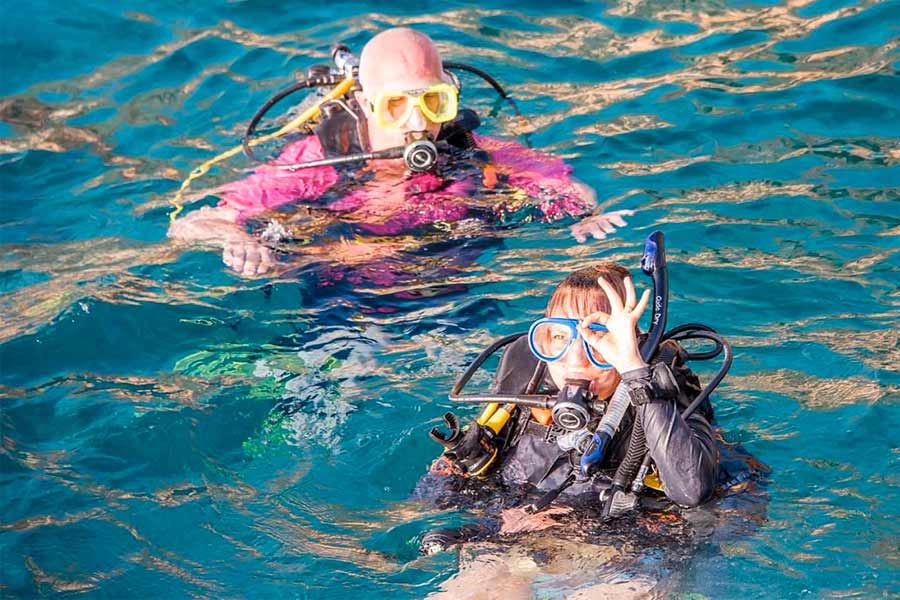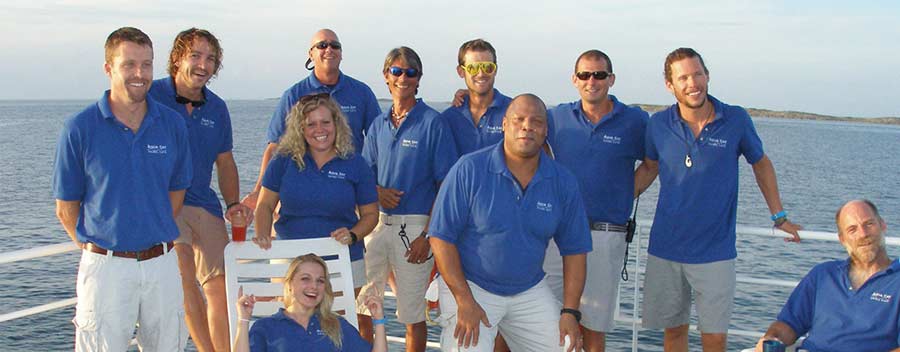
Dive liveaboard trips truly are the best way to explore many of the world’s most impressive scuba destinations – but what if you have a problem onboard?
Comfort, excellent service, and the ability to visit and area’s most remote dive sites make liveaboards a very attractive option for serious divers and those who want to veer off the path most-traveled. However, the same remoteness and seclusion that make liveaboard trips great can also make travelers nervous.
There is probably little to no phone service, medical attention could be hours away, and diving repetitively for a week or more increases the possibility of problems – fortunately, this is all accounted for!
The likelihood of an emergency occurring on your liveaboard trip is very, very small, but it’s always best to be prepared for anything. Keep reading to learn more about how problems are solved on liveaboard dive trips – including anything from a blister to the bends.
Common Problems on Liveaboard Trips

The vast majority of problems encountered on liveaboard vacations are small issues that can be quickly fixed, and the staff should be well-trained to handle more serious issues. The most important thing to do in ANY problem situation is to communicate with your liveaboard crew!
We always suggest purchasing trip insurance and dive insurance to make sure that you’re covered in almost any situation. We recommend DiveAssure and Travelex.
Solving Dive Gear Problems on a Liveaboard Trip
Usually, dive gear issues are the easiest to solve. If you’re unable to fix the problem yourself, just mention it to someone on the dive team! If something like an O-ring or a mouthpiece needs to be replaced, a dive instructor will probably know where to find a spare onboard. Even better, bring your own “save-a-dive kit” with spare O-rings, fin straps, zip ties, etc. This could save you a lot of trouble in a remote place!

If the gear can’t be fixed with tape or a quick replacement part, there may be some equipment that you can rent on the boat. It’s a good idea to check in advance to see if gear rental is available on the liveaboard you’ll be joining.
It’s also a great idea to bring a backup of anything you think might fail. You never know when a computer could break – having a spare clipped on your BCD could save a full day of diving if your primary goes out! A spare flashlight might just save you a whole trip’s worth of night dives. An extra carabineer might help you stay streamlined if your old one breaks. Backups can save you a lot of hassle if an equipment issue strikes.
Fixing Minor Health Issues/Injuries on a Liveaboard Trip

It’s never fun to feel bad, but it’s even worse when you’re on vacation. And even worse than that is while you’re on a boat and missing dives! Communicating with your liveaboard crew is absolutely key when you’re experiencing a health issue onboard, no matter how small.
Something as minor as a fin rub blister can really put a damper on your dives, but a divemaster could easily patch it up with a piece of tape. Or maybe they have an extra pair of swim socks to lend you.
Being congested is pretty common after flying, so the fact that divers often experience it on the first day or two of dive trips makes a lot of sense. If you’re getting a headache while trying to ascend, take it slow – and mention it to the crew. They probably have tips for ascending safely, and they may even have a decongestant for you to take (keep in mind that some divers are strongly against taking decongestants before diving).
Of course, walking around a boat with wet feet inevitably leads to some stubbed toes and scraped knees. A good liveaboard crew will absolutely have the first aid necessities to bandage it, and they most likely have something like ibuprofen or Tylenol to keep you from feeling too banged up. The same goes for stomach problems, sea sickness, or any other day-to-day health issue: The boat will have a stash of medication and plenty of bandages to keep you going strong.
Solving Travel Issues on a Liveaboard Trip
Running into problems while traveling is never ideal. Whether it’s a delayed or canceled flight, lost luggage, or something more severe, it’s a rough way to start a trip. As always, having a trip insurance policy will cover you in that worst case scenario of not making it to the destination. DiveAssure and Travelex are our preferred providers.
Your first line of defense should be emergency contact information provided by the operator. Sometimes, this will be a direct number to the boat. Other times, it will be a mainland office who can reach someone in the destination with ease. You should keep these phone numbers accessible without needing Internet connection.
Aspects of travel arranged through the liveaboard company are often easily solved. However, keep in mind that changes are not always possible – especially without sufficient advance notice. The emergency contact will help however they can, or they will put you in touch with the person who can help with your specific situation.

Anything arranged separately from the liveaboard will probably be out of the hands of your emergency contact, but they are sometimes able to put you in touch with the right person. If you’re working with a travel agent, the emergency contact info they provided is usually the best place to start. No matter who you’re working with, it’s important to keep the liveaboard company in the loop.
Making Requests on a Liveaboard Trip
When you’re on vacation, especially a luxury trip, wanting things your way is normal. Generally, explaining what you want to the crew will solve the problem when a solution is possible. It’s important to keep in mind that there are limits to what is possible (staying on a boat is inherently different than staying on land), but most things are just a quick comment away!

Is it too cold in your cabin? Odds are, the crew will be able to help you adjust the thermostat for a more comfortable temperature, or they’ll be able to provide extra blankets at the least. Do you prefer to move slowly when you dive? Mention it to the guide! They’ll probably be happy to lead a more leisurely exploration of the site.
Keep in mind that there’s probably a very good reason if the crew is unable to accommodate your request. They want you to have a perfect trip! It’s their job, and tips are the biggest portion of their earnings, so they’ll do everything they can to make your trip flawless.
Solving Dietary Problems on a Liveaboard Trip
Vegetarian, vegan, gluten-free, pescatarian, and allergies of all kinds are usually not a problem to work with on a liveaboard – but this needs to be discussed long before you’re on the boat. You should confirm that the boat can accommodate your needs when you’re booking the trip. You should also mention it on the trip application to ensure the boat orders the correct foods and follows the correct procedures for your meals.

It is important to note that some dive destinations have more access to specific items than other places. Even nearby countries like the Bahamas don’t always have everything you can get in your local grocery store. Ordering a highly specific item in remote parts of Indonesia is simply not possible.
However, most chefs are very experienced with many different dietary restrictions, so they are almost always able to make some incredible meals that work with your diet if advance notice is given.
If you’re worried about dining options onboard, packing some food from home can be very handy. It’s not a common occurrence, but miscommunications regarding dietary restrictions are possible. If you get to the boat and aren’t happy with the food options, step one should always be talking to your crew. They will do whatever they can to help, but the provisions ordered could be a limitation to what they can offer if they were purchased without knowing about a particular dietary requirement.
Bringing some foods/drinks of your own can help quite a bit if you find yourself in a tight spot with the food served onboard. Packing an alternative source of protein can be especially useful for passengers who don’t eat every kind of meat. The likelihood of this chain of events occurring is very small, but being prepared for every situation is always ideal.
Marine Life Injury Care on a Liveaboard Trips
Typically, marine life injuries are very minor. Accidentally coming in contact with some fire coral or a sea wasp is not a fun experience, but some vinegar or warm water is usually enough to alleviate the symptoms pretty quickly. Even the dreaded lionfish sting is managed by simply soaking the area in hot water.

Any marine life encounter that results in an injury more serious than harmless scrape or sting will need to be evaluated by the crew – they’ll know whether it can be treated onboard or if professional medical attention needs to be sought. They’ll be basing the decision of the information you give them, so honesty is of paramount importance. A good liveaboard crew will always err on the side of caution. If a hospital visit is needed, the liveaboard will cruise that way as quickly as possible.
Following typical diving safety measures is the best way to avoid run-ins with marine life. Never grab a submerged line, and you should certainly never touch or harass a marine creature.
Solving Major Problems on a Liveaboard Trip
While they are extremely rare, serious problems do happen on liveaboards from time to time. Avoiding these issues is the number one priority of your liveaboard crew, but accidents happen. (That said, following safe diving protocols and listening to the crew’s direction will reduce the risk of serious issues to an extremely low level.)

Any respectable liveaboard will have a well-rehearsed procedure for anything that could be dangerous to the people onboard. Procedures for handling DCS, other serious medical problems (like heart attacks or injuries), and problems with the vessel itself are practiced through frequent drills to ensure that each person in the crew is familiar with the process and able to help.
In these situations, it’s best to follow the direction of the crew quickly and precisely. They have the proper training and experience to facilitate a safe solution to whatever the problem may be. Also, being honest on your trip application in regard to medications or pre-existing conditions is absolutely necessary for your situation to be handled correctly.
In the case of a major emergency, an air evacuation could be necessary. Aside from the fact that any situation that requires an evacuation is probably life-threatening and ruining the trip for every other passenger, these evacuations are also extremely expensive. A diver can expect thousands, possibly even tens of thousands, of dollars out of pocket if he or she does not have dive insurance. We recommend DiveAssure.
Divers should avoid emergencies like this at all costs. Among other ways to avoid DCS, liveaboard divers need to drink plenty of water, rest sufficiently, refrain from heavy drinking, and never push the limits of a computer. Diving with nitrox is also a great way to extend bottom time so pushing the no-deco limits is less tempting.
Below is a list of common several common symptoms of decompression sickness. If you experience any of these on a dive trip, let your crew know ASAP. They will evaluate the situation and provide assistance.
- Fatigue
- Joint/Muscle Aches
- Numbness/Tingling
- Paralysis
- Blotchy Rash
- Itchy Skin
- Vertigo/Dizziness
- Shortness of Breath
- Confusion/Clouded Thinking
- Nausea


